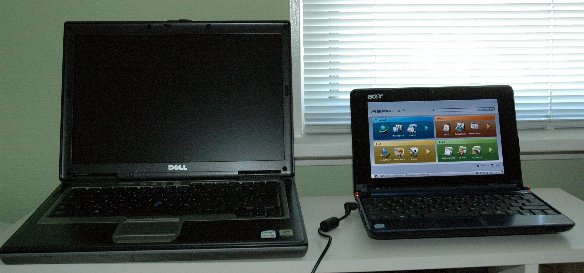I paid for Xfce
Yesterday I caved in and bought myself one of those cute little laptop devices: an Acer Aspire One.

Note that the giant machine on the left is my previously considered smallish 14.1″ laptop from Dell.
It comes with a Taiwanese distribution, Linpus Linux, based on Fedora 8. More specifically, it comes with the ‘Lite’ variant of the distribution which features Xfce as its desktop environment. Well, actually, it is part modified Xfce, part Easy(tm) interface created by Acer for this device (they call it xfdesktop2, a bit strange if you ask me).
Wow. A commercial offering available from a store for regular people, with software that I helped create. Awesome. Maybe I should have asked for a discount ;-)
I’ve just started playing with it and I think they did a pretty good job. The interface is really easy, but can only access a few predefined applications. I have wanted to write such a full screen launcher/control center interface for a long time, but never got around to actually doing anything about it. It would be perfect for my parents, who have a very hard time working with their Windows XP.
They use a modified Thunar (My Disk://, Removable://, indication of disk usage in the side bar) that seems to work fairly well.
They don’t provide easy access to changing the configuration, since they disabled the right mouse menu on the panel. However Alt-F2 brings up xfrun as in a regular Xfce installation and Terminal is installed.
There’s xfce-setting-show to bring up our own settings dialog. It doesn’t fit on the screen (1024×600), but this is partly due to the very big icon they added for screen settings, making all buttons in the dialog much bigger than they need to be. I got rid of the XP window decorations and used the Xfce theme instead of RedHat’s Nodoko. Now that looks better!
xfce4-panel -a gives you the add item menu, where you can add for instance the xfdesktop menu. Also in edit mode some right-click menus do become available (not all). I’ve added a menu and a pager to get a bit more functionality.
Since it’s based on fedora you can use yum to install more software. I’ve just installed gimp to be able to create a decently sized picture for this post.
It has an 8GB SSD for storage and two card reader slots for possible extensions. The one thing where the SSD really shows its advantage is boot time. It boots in about 15 seconds, maybe a bit less (although some daemons are still being started in the background), very nice indeed.
Oh, and it weighs slightly less than 1 kg.
So, now I’ll go back to playing with this thing ;-)
update:
Screenshot